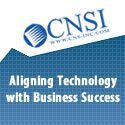
Chris Bishop is the Senior Vice President of Sales at ManTech International Corporation (ManTech), a multi-billion-dollar public company that provides services to the federal government in the areas of defense, intelligence, law enforcement, science and administration, among other fields. Chris is in charge of leading all sales efforts for the Herndon, Va.-based company’s Mission Solutions and Services Group, including identifying strategic growth areas and developing implementation roadmaps to penetrate new markets and obtain new customers.
Chris recently spoke with WashingtonExec about the way trends in the government contracting industry are affecting ManTech’s business strategy, how his company continues to drive success in a cost-constrained environment, and keeping top talent engaged at ManTech to help ensure the company’s growth.
Our first topic of conversation was a tough one – current market trends and how sequestration and LPTA are affecting contractors. “Unfortunately, I believe we’re going to see continued strong headwinds in our core markets and can anticipate at least two to three more lean years, particularly in the DOD market,” Bishop said. “The U.S. defense drawdown, Asia-rebalance, regional crises and destabilization, and heightened threat posture creates uncertainty, but may also create opportunity in key market segments. Similarly, the market dynamics in the contracting environment are continuing as well. Industry seems to have struck a ‘new normal’ in the competitive landscape, including key trends like acquisition delays and protests; shorter duration, smaller task orders; commoditization of knowledge-based services; small business set-asides; low-priced, technically-acceptable evaluation criteria; and intense price competition. While we do see some signs of the pendulum swinging back, I think we’ll continue to see these trends throughout our industry for the next several years.”
Chris also spoke about LPTA, specifically, and how it has – and will continue to – play an influential role in the industry. “LPTA has been around for a long time, but its prominence in the marketplace has never been greater,” he said. “For the most part, LPTA, or the importance of price, will continue to play a role. However, it really depends on the market, the technology, the nature of the work, the importance and criticality of the mission, the timing and criticality of it as well. We’ve had some customers that have refused, under any circumstances, to do LPTA because they could not get the quality of service they wanted. In other cases, where clients view the product solution as a commodity, they clearly state they’re not going to pay a big premium for something they consider to be a commodity. That said, we still have some customers that are using the definition of commodity a bit too broadly, including some higher-end, engineering, and knowledge-based services. While we still see some of that behavior, our customers are really deciding for themselves which side of that fence they sit on.”
Not surprisingly, the “new normal” Chris spoke about has forced companies to adjust their strategies, and ManTech is no exception.
“These contracting environment trends have forced us, and the industry as a whole, to reexamine what we bid, how we bid, and perhaps how we execute work,” Bishop said.
However, ManTech is viewing these challenges as opportunities, and Chris and his team are leading the company to positions that are advantageous in this harsh landscape. “There is no shortage of opportunities to bid, but what it takes to win in today’s competitive landscape is entirely different,” he said. “We are focused on early identification and positioning and determining what opportunities are winnable, not just biddable. We are working closely with our customers to ensure that we understand their definition of ‘technically acceptable.’ Then, we work diligently throughout the solutions development and capture strategy development phases of our BD lifecycle to design an innovative, compelling solution that meets the competitive price points of the environment.”
One of the most challenging tasks when operating in a cost-constrained environment is to continue providing the high-level services clients expect from a company like ManTech. I asked Chris how his team is meeting that challenge.
“Building compelling technical, cost-effective solutions may be the most challenging aspect of today’s cost-constrained environment,” he said. “No longer do we have a sufficient bench of available technical SMEs and solutions engineers to engage across the full breadth of opportunities we have. We have invested heavily in our business development, capture management, and solutions engineering capacity to support our volume of bids in key markets across specific technical solution areas. We pair these resources up with SMEs from the line organization to build innovative, compelling solutions for our customers. Solutions development is a challenging, multi-disciplinary activity requiring a broad array of skills to build integrated technical, management, and business solutions. Early identification of the necessary skills and disciplines, and applying those resources to only those specific “winnable” opportunities, is essential.”
Even though serving clients with the same level of excellence is critical, despite outside factors that may prove challenging, companies must still look within their walls to be sure that excellence is being driven from the inside. I asked Chris how ManTech continues to engage its employees and how this engagement helps the company to do more with less.
“We have thousands of employees located throughout the world, most of which are co-located with the customers they serve,” he said. “We’d be missing out on one of the most valuable resources we have if we didn’t engage employees in our new business development activities. Whether we’re talking about customer domain understanding, generalized competitive intelligence, or specific technical guidance and direction, our employees are force multipliers for our business development activities. They are our greatest and most cost-effective source of knowledge and experience, which allows us to reach broader and deeper across our customer base.”
Chris then listed several key initiatives ManTech is using to better engage its employees:
“1. Performance Management and Incentives: We define specific goals and objectives for all employees and we incorporate growth expectations and objectives for many levels of employees. And correspondingly, we reward employees for contributing to our growth through bonus and incentive plans.
2. Training: We have published an extensive library of capture management and proposal development coursework on ManTech University. Through the Learning Management System we can track who has taken training to ensure that we can leverage their skills as soon as possible. We use these learning modules to make sure that all employees are well-trained before they get engaged in a proposal. We save a tremendous amount of money by avoiding unnecessary use of consultants and avoiding rework.
3. Solutions Development: An excellent opportunity for employees to engage in the business development and growth of the company is through our opportunity solutions development process. Here, employees that have specific functional, technical, or domain knowledge can engage to help influence strategy and develop compelling/innovative solutions for customers they may already know.”
As Senior VP of Sales, Chris is charged with leading ManTech through business development obstacles. “One of the most significant challenges we have in this current environment is the ability to accurately predict and forecast business development activities,” Bishop said. “Our customers struggle daily with their own budgets and activity forecasts and as such seem to have less visibility into upcoming procurement timelines. For me, early visibility is essential. It really begins with our strategic planning efforts that define our target, strategic markets and customers. Through this process we identify a portfolio of opportunities to carry through qualification and capture. This helps focus our attention in specific market segments and avoids our business development staff from being spread too thinly across too many markets.”
Chris went on to describe how ManTech handles these particular market segments and how careful planning is one of the company’s main ingredients for business development success.
“We try to stay close to our customers and acquisition offices in an attempt to maximize visibility in opportunity forecast. Our business development process encourages early ‘gating’ (or reviewing) of opportunities so we can assign the right resources, early enough in the process to meet our stringent ‘solutioning acceptability’ thresholds. Even with that, we rarely seem to have as much time as we’d like, especially with our extensive portfolio of GWAC/IDIQ contracts. ManTech has developed, and we continue to fine-tune, a flexible/adaptable task order response mechanism allowing us to bid opportunistically into key customer environments.”
By the end of our conversation, Chris had shared a lot about ManTech and his role in leading the company to new business opportunities. However, we urged him to share a bit about his life outside the office, and here is what he had to say:
“Lacrosse seems to have become our family hobby over the last several years. I first got into lacrosse in college at University of Virginia. Now, both my boys play lacrosse nearly year-round with several different teams, and that consumes a lot of our time. Even my daughter managed the Girls Varsity lacrosse team when she was in high school. I also coach year-round and still play occasionally when my schedule permits. My wife is a great sport through all of this; in fact, she puts up with a family trip every year to go to the opening round of the NCAA lacrosse tournament on Mother’s Day!”


